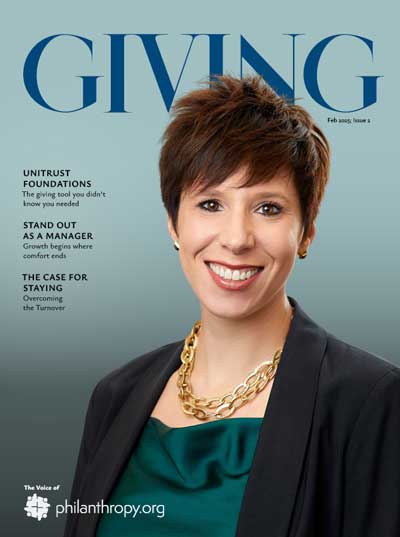A Seven Point Planned Giving Action Plan
Many development officers are wondering where to focus their efforts during these uncertain times. Whether times are good or bad, the answer may surprise you:
It’s planned giving.
Why? Because many of the things that were keeping you from focusing on planned giving before — special projects, a capital campaign, major gift solicitations — are likely on hold during bad times. And during good times? Well … now you’ve got the luxury of “time”.
Regardless, here’s a Seven Point Planned Giving Action Plan:
- Shift your focus. Officially shift your focus from current to deferred gifts. Start thinking loyalty, not capacity, and move planned giving to the front burner. Implement this seven point action plan. Most of your major donors are on the sidelines, but your “loyals” can still make deferred gift commitments — especially bequests.
- Keep showing up. Anytime is the worst possible time to discontinue your planned giving marketing program. Your constituency will notice and it will undermine their long-term confidence in your institution. Instead, tailor your messages to acknowledge the challenges of the times, but keep offering them your best gift planning ideas. Publicly highlight any realized bequests you receive during this period. Remind people that their estate or deferred gift commitment may make the critical difference in your institution some day. It’s worth noting that 8 out of 10 of the largest gifts received by American charities in 2008 were given by dead people (realized bequests), whereas all 10 of the largest gifts the previous year (2007) were given by living people!* We do not have stats yet for 2020, but I bet we’re not far off.
- Publicly thank your “loyals.” Over 90% of planned gifts come from people who have given loyally for many years to the institution they eventually benefit. Take this time to formally recognize and thank your loyals. How? Publish a list of all your 10+ consecutive year donors with a “thank you” letter from the CEO, Head, or President of your institution publicly thanking them for their years of loyal support. They are the bedrock of your support and the reason you can be optimistic about your future in these tough times. They will always be there for you—especially if they include you in their estate plans! A thank you in tough times feels a lot more genuine than one in easy times, and it serves as a gentle reminder that you are depending on them for their continued support.
- Start a “True Blue” Society. If you don’t have one already, start a “true blue” society—a special recognition society for donors who have given 10 or more consecutive years. These are your planned giving donors in training and now is the time to encourage and reward their loyalty. Remember,15 is a magic number. When a donor reaches 15 consecutive years or 15 gifts to the annual fund, he or she is 6-8 times more likely to make a planned gift than the rest of the file. Give special recognition to this group in your annual report and other publications. After a few years, you will find that your “true blues” will call you at the end of the fiscal year to make sure you received their gift! Put every one of them on your visit list.
- Call. Call. Call. Before the pandemic it was Visit, visit, visit. Times will change. Make as many “face-to-face calls” as you possibly can this year (instead of emails). Break a record. Ask how they are doing. You will never have a better opportunity. Run a consecutive years giving report, organize it geographically, and start at the top with the longest years given. Loyals almost always take your call and they will usually see you, especially if you emphasize that you want to thank them in person for their years of loyal support. Start gift planning conversations with your loyals by asking them if they would ever consider including you in their long term plans. Remember, the average response rate when you visit or call a loyal is close to 20%. Compare that with the average response rate to planned giving direct mail of .5% or less. Add your existing planned giving donors to the list so you can verify and quantify their commitments. A warning about the calls you make: your donor may keep you on the phone indefinitely.
- Adjust your marketing focus. Emphasize gift plans that: 1) cost nothing now, such as bequests and beneficiary designations of retirement plans and life insurance; 2) provide security, such as gift annuities; or 3) offer a unique opportunity, such as gifts of whole or fractional interests in real estate or charitable lead trusts for high net-worth donors. Encourage your donors to make percentage bequests rather than specific dollar amounts, so that you can grow with them when the market recovers. If you have a gift annuity program, write as many gift annuities as you can. From an institutional standpoint, every gift annuity you write now locks lower risk into your pool later. This is the best time in living memory to do a charitable lead trust. Talk to your high net worth donors about the benefits.
- Quantify your pipeline. If you haven’t already, use this time to formally document and quantify your pipeline of planned giving commitments. Develop a report that shows all of your planned gifts classed by gift type and known or unknown value. Work on filling in the holes in the data, such as quantifying commitments of unknown value. Share this report with your Development Committee and your Board at least twice a year. I guarantee you that the aggregate amount will get their attention and will begin to focus their thinking on the long term benefits of planned giving. Also, share this report with your planned giving recognition society. It will help them to see that they are part of a larger effort that is making a big difference in the future of your institution.
In conclusion, any economy offers you an unparalleled opportunity to focus your time and energy, free of the usual distractions, on advancing your planned giving program. Take advantage while you can, and create a planned giving action plan.
*Rachael Larimore, “The 2008 Slate 60: The largest American charitable contributions of the year” in Slate (January, 2009) http://www.slate.com/id/2209476/
Share with your board:
The importance of planned giving from a financial perspective, and
The importance of planned giving from a strategic perspective.
Category: Planned Giving Marketing



